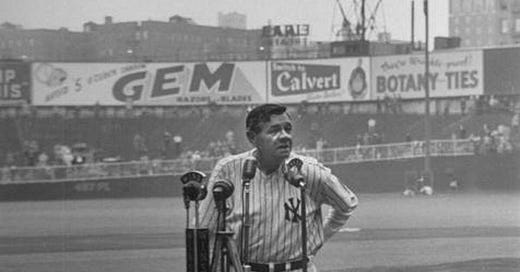
Hello everyone! I understand many of you are in the midst of family get-togethers where topics like science, war, Manchester versus Liverpool, and even baseball may be off the table.
If things start getting tense, I invite you to try this line: “Did you know Babe Ruth was one of the first people to get chemotherapy?”
*table goes quiet*
“Yup. And thanks to him, we cured childhood leukemia. Crazy story, man. Let me tell you about it.”
(You can also suggest your relatives subscribe to Cancer Culture. Or just sign them up by clicking the button below.)
Let’s play ball!
In the pre-aviation era, the only way to cross the Atlantic was via ship and many companies vied for the business of wealthy travelers. We are all familiar with the Titanic but a French competitor, the Île de France, was, by most accounts, even more grand.
The ship’s extravagant Art Deco interior attracted celebrities and royalty with luxury cabins costing upwards of $54,000 in today’s dollars for the weeklong cross-Atlantic voyage. The glittering crowds schmoozing on her decks earned her the nickname “Floating Hollywood.” In 1939, the Île de France was the last vessel to leave Europe before France and England declared war on Germany. In 1937, however, the ship carried precious cargo.



Dr. Daniel Laszlo, a cardiologist, his wife, a psychiatrist who trained under Anna Freud, and young son anxiously boarded the Île de France bound for America. The affluent Jewish family was fortunate to have secured jobs and a sponsor in the United States, clearing two of the high hurdles put in place by the US State Department to slow the tide of European Jewish immigrants fleeing Nazi violence.
After arriving in New York harbor amidst a hurricane, Dr. Laszlo, also a talented chemist, searched for work and a steady income to support his family. With the help of friends, he secured a job at Mount Sinai Hospital studying the effect of vitamins like folate in treating tumors in mice models. One compound he tested was teropterin. A folate antagonist extracted from brewer’s yeast, injection of teropterin resulted in tumor shrinking and when injected into tumors in rats.
Right about the time the Laszlo family arrived in New York harbor, the Great Bambino was searching for purpose in his retirement. On May 25, 1935, an out of shape Babe Ruth hit three home runs at Forbes Field against the Pittsburgh Pirates and retired eight days later. His record of 744 career home runs stood until Hank Aaron passed it almost 40 years later.
Years of hard living had left their mark on Babe Ruth. He spent his retirement golfing and hoping to be called back to manage the Yankees. He also lent his celebrity status to encourage American involvement in World War II. In 1942, the German American baseball hero signed his name to a proclamation from the World Jewish Congress denouncing Hitler’s atrocities and pushing FDR to enter the war.
During the fall of 1946, Ruth noticed that his voice was becoming hoarse, and he complained of excruciating pain behind his left eye. His health continued to deteriorate to the point where he could barely speak or swallow. He lost almost 80 pounds. An x-ray finally revealed a large tumor at the base of his skull and his doctors prescribed an intensive round of radium treatment (ouch!), which did little to stem the tumor’s growth or his painful symptoms.
Babe Ruth was finally admitted to Mount Sinai Hospital, just floors about Daniel Laszlo’s lab. Unaware of the celebrity patient, Dr. Laszlo was surprised when his boss, Dr. John Lewisohn, rushed into his lab and demanded he turnover his entire supply of teropterin to use on a human patient. Laszlo balked.
His son recalls, “My father said he couldn’t do that because it had never been given to patients. They didn’t know what the dose was, how much to give, how long to give it, and so on. However, the hospital director wouldn’t take no for an answer, even though my father thought it was unethical to do that.”
Over Laszlo’s objections, Dr. Lewisohn insisted that he hand over the compound. It is unclear how Dr. Lewisohn decided how much of the compound he decided to give his celebrity patient, but Ruth’s symptoms began to improve. The drug seemed miraculous, “The tumor disappeared. Ruth had come in miserable shape and went home feeling just fine.”
On June 13, 1948, an emaciated Ruth felt well enough to don his old Yankee pinstripes and played a starring role at the 25th anniversary celebration of the opening of Yankee Stadium.
Ruth’s response was short-lived, however, and he spent the next few months in and out of the hospital. George Herman “Babe” Ruth died on Aug. 16, 1948. His autopsy revealed metastatic cancer originating from the nose and throat. His body lay in state at Yankee Stadium for two full days, where hundreds of thousands of fans paid their last respects; his funeral was held before a jam-packed crowd of dignitaries at St. Patrick’s Cathedral on Fifth Avenue.
A New York Times article highlighted Ruth’s dramatic role as the first human to receive treatment with teropterin: “His improvement gave the medical profession the world over hope that cancer could be combatted successfully by the simple administration of a drug.”
By this time, however, Daniel Laszlo was gone from Mount Sinai and John Lewisohn is the only physician mentioned in contemporaneous reports. Frustrated by the unethical administration of an unproven medication (possibly informed by his knowledge of the Nazi’s medical experimentation on his fellow Jews in concentration camps), Laszlo transferred to Montefiore Hospital and established the first hospital ward dedicated to caring for cancer patients.
The doctors at Mount Sinai “were very interested in it, but didn’t quite believe it, so they asked Dr. Sidney Farber from Harvard to comment on it. He pooh-poohed the whole idea and then took it over himself.”
According to the junior Dr. Laszlo, also an oncologist, THE central subject of the Pulitzer Prize winning book and Ken Burns documentary series, The Emperor of All Maladies, based his groundbreaking research on Laszlo’s work, but never credited him.
Dr. Farber’s discovery of methotrexate remains the backbone of childhood leukemia treatment today and would not have been possible without Daniel Laszlo’s work at Mt. Sinai and Babe Ruth.
When it comes to cancer, I don’t care about the color of your jersey or the letter behind your name. Petty fights about this or that distract us from the real work that needs to be accomplished. Science will always be political (the vast majority of cancer funding comes from the US government) but it doesn’t have to be partisan.
Whoever has the best idea to decrease the burden of cancer in this world, step up to the plate and let’s do this.
On my mind…
The University of Alabama has a new exhibit on tobacco companies’ advertisements that targeted women in the early 20th century. One suggested that women should reach for a cigarette instead of candy. Lordy.
Florida State offensive lineman Dillan Gibbons created the non-profit Big Man Big Heart to help other NCAA athletes donate a portion of their NIL money. Mad props to Dillan and other college athletes like him.
On November 30th, the Healthcare Businesswomen’s Association met in Basel, Switzerland to discuss ways to solve health challenges endured by women in the workplace including infertility and menopause. Huzzah!










What a great ride through a surprising journey!